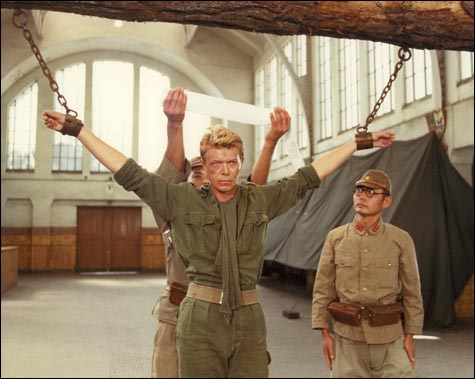The HFA looks back at the bad boy of Japanese cinema
By BRETT MICHEL | December 5, 2008

MERRY CHRISTMAS MR. LAWRENCE: Treading lightly on the homoerotic tensions in a POW camp. |
| “Nagisa Oshima and the Struggle for a Radical Cinema” | Harvard Film Archive: December 7-22 |
Credited as one of the originators of the Japanese "New Wave" alongside Masahiro Shinoda, Kiju Yoshida, and the late Shohei Imamura, director Nagisa Oshima (born 1932) — who's being celebrated at the Harvard Film Archive this month — is among the generation that came of age during wartime and its uncertain aftermath. Working under the aegis of iron-fisted Shochiku Studio head Shiro Kido, Oshima and his contemporaries rejected the slick, Hollywood-inspired productions that Shochiku had been known for turning out month after month in favor of nihilistic films featuring the generation of sex-crazed, violent adolescents known as the "taiyozoku," or the "Sun Tribe."This new genre came of age (and gained its moniker) in 1954 when rival studio Nikkatsu released Takumi Furukawa's Season of the Sun, which was based on Shintaro Ishihara's award-winning novel about youths gone wild. But it was Ko Nakahira's immensely popular tale of depraved delinquents, Crazed Fruit, which Nikkatsu released two years later, that opened Oshima's eyes to a new generation of Japanese film and paved the way for his landmark CRUEL STORY OF YOUTH (1960; December 8 at 7 pm). This widescreen Technicolor shocker was unprecedented in its toxic depiction of sex, violence, and anti-American sentiment. Shot in a free-form, unpolished style with hand-held cameras, it recalls the classic that helped launch the French New Wave, Jean-Luc Godard's Breathless, which was released the same year.
The critical and commercial success that greeted both Cruel Story of Youth and his subsequent taiyozoku-themed picture, THE SUN'S BURIAL (1960; December 8 at 9 pm), were a vindication of Oshima, whose first film for Shochiku, A TOWN OF LOVE AND HOPE (1959; December 7 at 9 pm), received only limited distribution. Kido hated the end result, though perhaps not as much as he disliked Oshima's preferred title: The Boy Who Sold His Pigeon. The story of a thieving schoolboy whose scheme involves selling a homing pigeon that he's trained to return home shortly after he gets paid takes place in a town that offers him neither love nor hope. Still, the film elicited positive reviews.
Tensions with Kido came to a head upon the release of Oshima's fourth film, NIGHT AND FOG IN JAPAN (1960; December 12 at 7 pm), a political essay (and homage to Alain Resnais) that rails against both the right and the left and their inability to forestall the inevitable renewal of the controversial US-Japan Security Pact. Although the 43 highly theatrical extended shots that constitute the film would make Resnais (and even Godard) proud, Kido, who hadn't been aware of the film's secretive shoot, took great offense at the picture's radical political content, pulling the movie from theaters after just three days in limited release.
 Related
Related:
Review: Petition, Balkan Rhapsodies: 78 Measures of War, Somber skies, More 
- Review: Petition
This distressing documentary explores a netherworld of individuals who have come to Beijing from all over China hoping that their grievances against their local governments will be heard.
- Balkan Rhapsodies: 78 Measures of War
Is there some poison in the air of the Balkans, as one individual asserts, that breeds eternal ethnic bloodletting?
- Somber skies
The 10th Magners Film Festival
- All's well that is Welles
Some of the best of the last Orson Welles flicks at the HFA
- Sweet smell of skill
Alexander Mackendrick, who's the subject of a tribute at the Harvard Film Archive this weekend, is a somewhat mysterious figure in movie history.
- William Friedkin at the Harvard Film Archive
However we may still praise, and therefore bury, the American New Wave, we do still run the genuine risk of slipping down the wormhole slicked by present-moment techno obsessions and amnesiac entertainment-media narcissism.
- Man make movie
Poverty is making a comeback, on the streets and on movie screens.
- Review: Dust
German documentarian Hartmut Bitomsky likes to make movies about how things are put together and how they come apart.
- Cursed films
At some point while watching the features in the Harvard Film Archive's "Le Film Maudit" ("cursed films") series — perhaps during the "Circle of Shit" chapter in Pier Paolo Pasolini's SALÒ, OR THE 120 DAYS OF SODOM — you might ask yourself, which is more cursed, the movies or anyone unfortunate enough to be watching them?
- Monster man and more
James Whale's career as a purveyor of marvelous film entertainments was brief.
- Prince of darkness
Gordon Willis, the master cinematographer to whom the Harvard Film Archive pays tribute in a seven-film retrospective beginning this Friday,
- Less

 Topics
Topics:
Features
, Entertainment, Music, Pop and Rock Music, More  , Entertainment, Music, Pop and Rock Music, Movies, Punk Rock, Jean-Luc Godard, Alain Resnais, Shohei Imamura, Shohei Imamura, Yasujiro Ozu, Less
, Entertainment, Music, Pop and Rock Music, Movies, Punk Rock, Jean-Luc Godard, Alain Resnais, Shohei Imamura, Shohei Imamura, Yasujiro Ozu, Less 